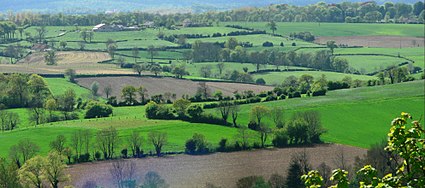
Back Boscatge Catalan Bocage Danish Bocage German Heĝkamparo Esperanto Bocage Spanish Bocage Basque بوکاژ Persian Bocage French Kûlisselânskip Frisian Bokaž Croatian

Bocage (UK: /bəˈkɑːʒ/,[1] US: /ˈboʊkɑːʒ/ BOH-kahzh) is a terrain of mixed woodland and pasture characteristic of parts of northern France, southern England, Ireland, the Netherlands, northern Spain and northern Germany, in regions where pastoral farming is the dominant land use.

Bocage may also refer to a small forest, a decorative element of leaves, or a type of rubble-work, comparable with the English use of "rustic" in relation to garden ornamentation. In the decorative arts, especially porcelain, it refers to a leafy screen spreading above and behind figures. Though found on continental figures, it is something of an English speciality, beginning in the mid-18th century, especially in Chelsea porcelain, and later spreading to more downmarket Staffordshire pottery figures.
In English, bocage refers to a terrain of mixed woodland and pasture, with fields and winding country lanes sunken between narrow low ridges and banks surmounted by tall thick hedgerows that break the wind but also limit visibility. It is the sort of landscape found in many parts of southern England, for example the Devon hedge and Cornish hedge. However the term is more often found in technical than general usage in England. In France the term is in more general use, especially in Normandy, with a similar meaning. Bocage landscape in France is largely confined to Normandy, Brittany, Burgundy and parts of the Loire valley.
- ^ "Bocage | Definition of Bocage by Oxford Dictionary on Lexico.com also meaning of Bocage". Lexico Dictionaries | English. Archived from the original on July 25, 2020. Retrieved 2020-07-25.
© MMXXIII Rich X Search. We shall prevail. All rights reserved. Rich X Search